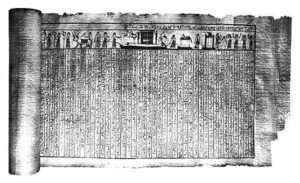Scroll searched by Jackson Elias and recieved from Hong Kong university:
GODDESS OF THE BLACK FAN
PHYSICAL DESCRIPTION
More a concertina-like scroll than a book, the beginning and the end of this long stretch of paper are attached to two thin black-lacquered wooden panels using thread tied through a pair of holes in each block (4”×10 ½”). Unfurled, the paper runs to approximately 50 pages of text. Folded, accordion-like, it is held shut with a ribbon of coarse black material. Several Chinese characters have been inlaid on the opening wooden panel in gold leaf (“heishan shen nü” which literally reads as Black Fan Goddess in English). The contents are in Classical Chinese.
Chinese readers will note that the characters used for “Goddess” (shen nü) are also a euphemism for “prostitute,” giving the title a particularly curious dual-meaning for those unversed in its contents.
The binding method can be recognized as pleated-leaf binding (an Indian technique used for religious sutras, later adopted by the Chinese who call it Fan chia chuang), a fashion usually associated with Buddhist religious writings. This style was popular after the 1st century AD, though it can determined with little effort that the work was produced sometime in the mid-16th century due to the materials used.
Considering the fact that it was written in the middle of the Ming dynasty, but used Classical text and Han-era binding techniques it can be seen as oddly an anachronistic, if not deliberately archaic method.
CONTENTS AFTER QUICK SKIMMING:
The book is a long poem dedicated to a being referred to as the “Goddess of the Black Fan,” and describes the author’s murderous devotion to her. Over the course of many gruesome and terrible verses the author tells how he engaged in acts of kidnapping, murder, cannibalism, and what can only be described as bestiality, if not something far worse, all in the name of devotion to this Goddess. The poetic styling marks the author as a person of good education and, if the subject matter was not abhorrent to the extreme, a reader might go so far as to call it beautiful. Even a fleeting skim gives rise to feelings of disgust and self-loathing that will leave the average reader feeling physically ill.
QUOTES:
She stands alone in her temple
Alone atop a bejeweled dais
Her beauty would blast the heavens
Her eyes are dark green pools
A silken tunic she wears
Yellow and black in color, like a wasp
And in her belt she has tucked her sting
Six sickles, sharp as a dragon‘s tooth
Her face she hides behind a fan
Black metal, as black as darkness
My lady, remove your fan
I would feast upon your beauty
The fan flutters but does not fall
She simpers behind the fan and says
“You would make such requests of Me?”
Her voice is like iron shredding velvet
––‹‡›––
Why should Hsien have children when I
have lost mine?
He has never been an honorable man
If there were justice, he would have lost his
children
But thanks to the Goddess, there can be justice
again
Hsien’s house was quiet, and even the servants
and dogs slept
None heard me enter, none heard me leave
A dozing child in my arms, a baby in my
sack
All glory and praise to the Goddess of the
Black Fan!
––‹‡›––
Her eyes remained the same, so green and
deep
So rich and lovely, still could they put me in
a trance
Her eyes remained the same, yet when the
black fan fell
Everything else about her changed
I have focused on her fan and her eyes, but
now I finally see her
Before my eyes, she expands, now a bloated
slug, immense and howling
Her sweet mouth sprouts into five fangfilled
maws
Her arms become venomous snakes, thirsty
for blood
The dragon-toothed feaster towering above
me, her own temple too small
Her mouths open and five voices giggle
girlishly, licking the air
“Tell your Goddess that you love her, Liu
Chan-fang” she taunts
I love her, I love her, I love her, I love her, I
love her
––‹‡›––
Thus have I taken the sickle of the Goddess
and opened my belly
My quill is dipped into my own reservoir
and my own red ink
As my heart has bled for the glory of my
Goddess
Now let my heart bleed to commemorate her
horrors
With these words, my poem is completed
With these words, I die
All praise and worship to my Goddess
My Goddess of the Black Fan

